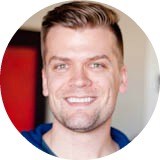I don't like the big hullabaloo around New Year's Resolutions.
The selfish part of me dislikes how many more people show up at the gym in January. While that's good for them (and the gym's finances!), I know that most will be gone by mid-February to early-March. It's just how it is every year.
The logical part of me doesn't believe that setting a New Year's Resolution works. I actually don't really like setting goals either, certainly not ones I shout from the rooftops, I prefer to set up systems. Focus on the process, the results will improve.
That being said, I do see New Year's Resolutions as a convenient “gateway drug” so to speak, to personal improvement. For many folks, the new year is a fresh start and if it spurs people to action, more power to you. I want to try to help in any way I can.
Personal productivity is something I've always been interested in. Years ago, I'd read Steve Pavlina's blog because it was one of the first personal development blogs ever. I remember learning about limiting beliefs from Steve, as well as polyphasic sleep… though I never tried polyphasic sleep. My best analogy is that he was Tim Ferriss before Tim Ferriss (and Ferriss has often cited Pavlina's resources).
One of the most valuable posts I've seen on his site was this one about how habit change is like chess. There's an early game, middle game, and end game. If you try to skip to the end game, you'll fail.
In the same vein of that post, I wanted to ask some of my favorite personal development and productivity bloggers to share advice about New Year's Resolutions. First, I'll share their thoughts in their entirety followed by my thoughts. Then, I tie it all together with a bow – a summary of the takeaways for the most effective way to “set” a New Year's Resolution.
Jeff Sanders, The 5 AM Miracle

Instead, I use and recommend a much shorter goal process that I call my quarter system. I only plan my life in 3-month chunks to create urgency, focus, and heightened enthusiasm towards my most important goals.
Here's an episode of my podcast that expands on the quarter system.
I was introduced to Jeff's podcast by a friend and look forward to checking out his book, The 5 A.M. Miracle shortly. Check it all out, including his weekly podcast, The 5 AM Miracle Podcast.
Henrik Edberg, Positivity Blog

To take just one small step at a time outside of your comfort zone. By doing so you can avoid procrastination and inner resistance.
For example, start by running for just 3 or 5 minutes. Then a week or two later, add a few more minutes of running.
Or start working for 5 minutes on something you have feared or been nervous about. Then you can go back to your regular stuff. And then come back and do 5 more minutes of work on that one thing later on that day or the day after that.
These small steps add up quickly. And it's far better to have traveled quite a distance over a year by taking small steps than to feel overwhelmed by taking that first big step and then just procrastinate on it for 6 months. Or to give up after the first 2 weeks.
Check out his blog at PositivityBlog.com and see what nearly 72,000 subscribers are learning every single week. Henrik also has five courses that can help you do everything from boost your self-esteem to stop procrastination.
David Cain, Raptitude

You have to identify benchmarks — where you can expect to be with it by February 1st, March 1st, et cetera.
Most resolutions are just hopes, with a little bit of initial enthusiasm. I hope I get in shape. I hope I make more money.
Make it a goal!
My good friend J.D. Roth, founder of Get Rich Slowly, turned me onto David Cain and Raptitude a short time ago. Since then, I've been very impressed with what David's been doing over there and fully understand now why J.D. recommended him so highly.
James Clear, JamesClear.com

Nearly every conversation about goals and resolutions is focused on some type of result. What do you want to achieve? How much weight do you want to lose? How much money do you want to save? How many books do you want to read? How much less do you want to drink?
Naturally, we are outcome-focused because we want our new behaviors to deliver new results.
Here’s the problem: New goals don’t deliver new results. New lifestyles do. And a lifestyle is not an outcome, it is a process. For this reason, all of your energy should go into building better rituals, not chasing better results.
Rituals are what turn behaviors into habits. In the words of Tony Schwartz, “A ritual is a highly precise behavior you do at a specific time so that it becomes automatic over time and no longer requires much conscious intention or energy.”
If you want a new habit, you have to fall in love with a new ritual.
I've known James for several years, back when he had a finance blog called Passive Panda, and one of my favorite habit posts was one he wrote for last year about why most habits fail. He has a very engaging writing style, his posts are packed with solid information, and you would do well to subscribe and join the near quarter-million other subscribers. 🙂
Donald Latumahina, Life Optimizer

To keep your resolutions, you need to have the motivation, and the motivation comes from knowing why the resolutions are important to you. If you don't have a big enough why you won't be able to keep your resolutions for long. Ideally, your why should be related to your life purpose.
Here is a post of mine on finding your life purpose.
Do yourself a favor and visit Donald over at Life Optimizer. With nearly 10,000 email subscribers and a library of posts, you can learn how to maximize your effectiveness. Plus, Donald is a programmer (or at least he used to be) so you know he's a good guy to know. 🙂
Jim Wang, Me! 🙂

To help develop this habit of writing, he would write an X in a calendar if he wrote that day. Over time, he'd develop this chain of X's in his calendar and he'd be motivated to write just so he wouldn't “break the chain.” The phrase “don't break the chain” refers to this idea. It's worked out pretty well for Seinfeld. 🙂
I implement this in my own life in many ways, from journaling to lifting. I aim to journal each morning and have maintained a pretty good habit despite a few breaks. The same goes for lifting, which also involves journaling my progress.
The key here is to use the chain as motivation but not as a handcuff. If the chain breaks, that stinks but no big deal. Start a new chain. Don't let the break derail you.
Some readers have asked me if there's a good online tool for this – yes, Joe's Goals is a very simple goal setting and tracking tool that gets the job done with unnecessary bells and whistles. You set up daily goals, track them with a single click, and see a nice string of green checkboxes. You can also set negative goals (things not to do) and those are red X's. So intuitive and there's even a logbook.
How to set a resolution you'll keep
As you read through the advice, you'll sense a theme – keep it small and manageable (you can always build on it for more), keep your focus very much on the why to maintain motivation, and whenever possible try to focus on the process and not the result.
It's no different than learning something new. You wouldn't try to become a world-class chess player overnight, right? Step one is to learn the board. Step two is to learn how each of the pieces moves. Step three… you get the idea.
Setting a resolution is also a bit of a misstatement because it focuses on the announcement, rather than the process or the result. “I want to lose 20 pounds this year!” may or may not be a bold statement but it does little to help you. You've probably always wanted to lose the 20 pounds… let's talk about how to lose that 1st pound in a way that makes the 2nd, 3rd, and 20th much easier.
With that common resolution in mind, how do we take our experts' advice?
- Jeff may advise that you break down your 20 lb goal into your four 12 week chunks – don't look at it as 20 lb but instead of four 5 lb goals. If you have 12 weeks to achieve it, it's now less than half a pound a week.
- Henrik (and Brian) may advise that you introduce additional exercise to your day, perhaps starting with a 15-minute walk each day. 15 minutes of walking for a 180 lb person is roughly 94 calories – seven days and you have 658 calories. It's not half a pounds worth of calories but it's a start. Couple that with a modestly lower caloric intake (you need to reduce it by about 150 cal/day – or one beer's worth) and the path to half a pound a week is within reach.
- David would warn against tying the weight loss to the NYR in the first place, don't make it a big thing! Just make it a project you're working on and not focus on how you're doing it because it's the new year. Just another quarter. You don't need a reset, there's no baggage here buddy.
- James may advise that you focus on the systems you need to build to make this a habit and not just a goal. How can you start a calorie log to get a better understanding of what you're putting in your body? Can you find yourself a walking buddy that will keep you accountable?
- Donald would sit you down and ask you – “why do you want to lose 20 pounds?” Do you want to lose this extra weight because you want to live longer to see your kids grow up? Do you want to be more fit so you can take care of your aging parents? Or do you want to look better in the mirror? Perform better in extracurricular activities like hiking or playing a sport? Understanding the why is extremely motivating and no “why” is better or worse, it's simply yours.
- Finally, I would just ask that you journal your progress and make that tracking your chain. Keep it up, don't break it.
What's your resolution, goal, or system you have for this year?
Many thanks to our experts!




Jeff Sanders says
Great article Jim! Thanks for including me. 🙂
Thanks for sharing your great advice!
Mike @ Tip Yourself says
Wow, tons of great advice! I especially like Brian MacFarland’s point about starting small and building momentum. That is definitely something that has worked for me in the past.
Thanks Mike!
Yeah that’s a solid piece of advice, it’s too easy to try to make a splash and a big proclamation… only to realize you bit off more than you can chew and abandon it entirely.
Aaron says
Like most, I don’t believe in new years resolutions. My system is to picture an equalateral triangle with 3 points representing health, money and relationships. My strategy is to expand the points on the triangle without distorting it’s shape. The goals I set support this strategy by providing a balanced focus within each area of my life.
I like the imagery of a triangle and those three points at the ends, it’s a good way of thinking about balance.
Romeo Jeremiah says
Hey, Jim!
No new year resolution for me but, I do have a few goals. I simply remember the phrase, “If it’s important to you, you’ll find a way. If it’s not, you’ll find an excuse.” Obtaining goals are more about the determination than the process. That’s the only way to start and keep on going…assuming the goals are S.M.A.R.T.
Determination is what gets you to FINISH the process. 🙂
Vic @ Dad Is Cheap says
Great and timely post Jim!
I love the Seinfeld example that you gave. It’s definitely important not to break the chain and keep consistency going. While I took some time off from my blog, I do want to get it to a point where I’m writing on a regular basis. I’d also like to apply this to being healthy. I’ve started journaling my runs and what I eat in the hopes I can be healthier.
I love the idea of finding your why. My biggest motivator is my wife and daughter, who I always look to to inspire me to become a better person.
Man you gotta get back in the saddle! I just mentioned your blog on a podcast (Radical Personal Finance) so you better start writing it again.
Vic @ Dad Is Cheap says
Haha! Just posted today! Hope to get on it in a weekly basis!
I work on a variety of posts at once, based on what I’m excited about at the time, and I do it in batches. I tend to write better in the morning earlier in the week, so I earmark Monday morning as my writing time. Then schedule things out and you’ll start getting ahead.
Or go to once every two weeks. 🙂